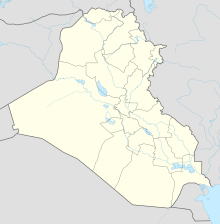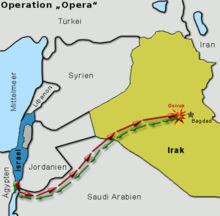Osirak
Coordinates: 33 ° 12 ′ 30 ″ N , 44 ° 31 ′ 30 ″ E
Osirak is the name common in the west for the Iraqi nuclear reactors Tammuz 1 and Tammuz 2 . It is a made-up word from the terms Osiris and Iraq . In Iraq, it was referred to as Tammuz 17 , referring to the Arab month on which the Ba'ath Party seized power in July 1968 , and this name is also used in Israel . The reactors have been built with French help since 1976 and the facilities were repeatedly attacked and destroyed by the military between 1980 and 1991.
Construction and use
The 40 MW - light water reactor was by French design in the nuclear research center Al Tuwaitha the Tigris (about 18 km outside Baghdad ) built.
Franco-Iraqi cooperation on the project began in 1975 with the signing of the Franco-Iraqi nuclear agreement. The then French Prime Minister Jacques Chirac not only supported French companies with the construction of the reactor, but also made it possible in 1978 to sell 12.5 kg of uranium-235 as fuel to the Iraqi government.
From 1976 France built the Tammuz-1 reactor (Osirak), a light water reactor designed for 40 MW th ; a smaller, second experimental reactor, Tammuz-2 (Isis) with 600 kW th , should also be built. Both reactor cores were damaged by sabotage on April 6, 1979, three days before they were shipped from France to Iraq in La Seyne-sur-Mer in the halls of the CNIM . Iraq should accept the resulting hairline cracks or wait 2 years for new containers. The Israeli secret service Mossad is suspected to be the originator of the sabotage .
It is believed that the reactor was part of the Iraqi program to develop an atomic bomb . Iraq also had facilities for the enrichment of weapons- grade uranium and had previously tried to buy nuclear technology from abroad, which was used, among other things, for enrichment. However, there were also some facts that spoke against the suspicion, including the reactor being checked by the International Atomic Energy Agency (IAEA) and the uranium should be returned to France after use.
Attacks and Destruction
Iranian air strike
On September 30, 1980, Iranian fighter planes attacked the reactor during Operation Scorch Sword , but were unable to damage it sufficiently.
Israeli air strike
About eight months after the failure of the Iranian attack (s o..) Launched on June 7, 1981 at 15:55 eight F-16 - a fighter-bomber and a fighter escort five F-15 the Israeli Air Force from the base Etzion on the Sinai , flew about 1,100 km above Jordanian and the Saudi Arabian border area and destroyed the reactor around 5.30 p.m. The pilots flew their machines so close together on the way to their destination that they looked like a wide-body aircraft on the radar ; the pilots simulated the radio traffic of a passenger plane by speaking Arabic.
During the attack, the fighter-bombers dropped 16 bombs, each weighing 1000 kilograms, with which an opening in the reactor shell was first blasted. Through this opening the following aircraft scored hits inside the reactor. Among the pilots who formed the end of the attack formation was the future spaceman Ilan Ramon . He later reported heavy smoke from inside the reactor and a huge explosion, which did not, however, cause the building to collapse. A French technician was also killed in this attack. In his book The Mossad , Victor Ostrovsky reports that this technician secretly worked for the Israeli secret service and had deposited a target transmitter there. But why he did not leave the facility could not be clarified.
American air strikes
During the second Gulf War , the facility was bombed several times in Operation Package Q Strike to prevent the continuation of an Iraqi nuclear program: on January 19, 1991, the facility was destroyed by 56 F-16s in several waves and on January 20 by F-117 -Fighter jets bombed; a total of 48 F-117s were used in seven further attacks, and later another 17 F-111s .
literature
- Amos Perlmutter, Uri Bar-Joseph, Michael I. Handel: Two Minutes Over Baghdad , Routledge Chapman & Hall 2003, ISBN 978-071468-347-8
- Clinton Dan McKinnon: Bullseye - One Reactor: The story of Israel's attack that destroyed Iraq's nuclear program. House of Hits, San Diego 1988, ISBN 0-941437-07-8 .
- Roger William Claire: Raid on the sun - inside Israel's secret campaign that denied Saddam the bomb. Broadway Books, New York 2004, ISBN 0-7679-1400-7 .
Web links
Individual evidence
- ↑ nti.org (PDF file; 671 kB) iraq nuclear , accessed on January 24, 2013
- ↑ Amos Perlmutter, Uri Bar-Joseph, Michael I. Handel: Two Minutes Over Baghdad , Routledge Chapman & Hall 2003, ISBN 978-071468-347-8

